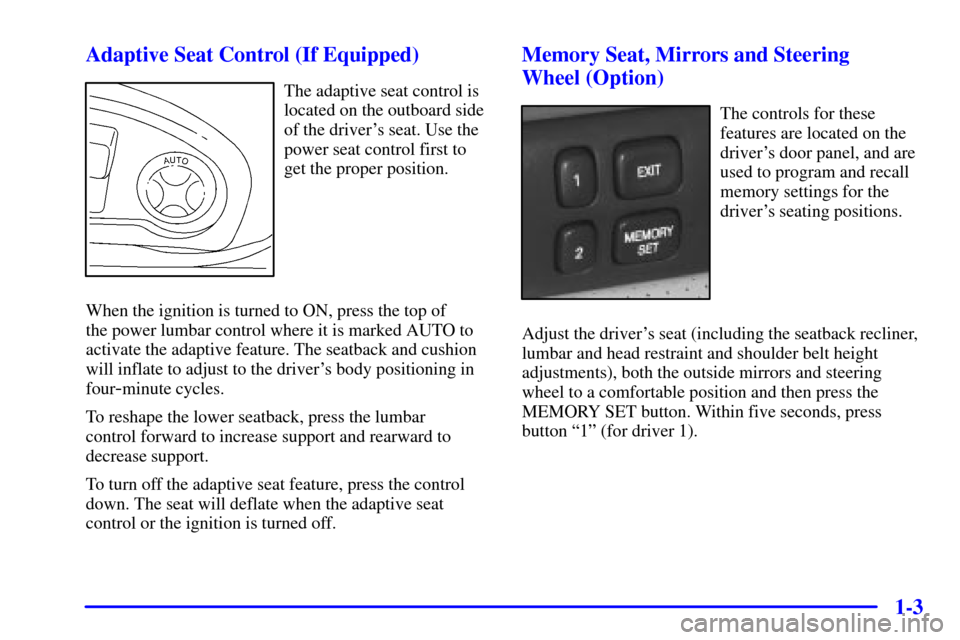Page 4 of 371
Table of Contents
Windows
Keys and Door Locks
Remote Keyless Entry System
Trunk Release
Automatic Transaxle
Parking Brake
Tilt Wheel
Turn Signal/Multifunction Lever
Windshield Wipers
Cruise Control
Exterior and Interior Lamps
MirrorsStorage Compartments
Convenience Net
Accessory Power Outlets
OnStar® System (If Equipped)
Sunroof (Option)
HomeLink® Transmitter (If Equipped)
Instrument Panel, Warning Lights and Gages
Driver Information Center (DIC)
Vehicle Programming and Personalization
Features (If Equipped)
Ultrasonic Rear Parking Assist (URPA) (Option) Seats and Seat Controls
Safety BeltsAir Bag Systems
Restraint Systems for Children
Section
1
Section
2
Seats and Restraint Systems
Features and Controls
ii
Page 11 of 371

ix
For example,
these symbols
are used on an
original battery:
CAUTION
POSSIBLE
INJURY
PROTECT
EYES BY
SHIELDING
CAUSTIC
BATTERY
ACID COULD
CAUSE
BURNS
AVOID
SPARKS OR
FLAMES
SPARK OR
FLAME
COULD
EXPLODE
BATTERY
These symbols
are important for
you and your
passengers
whenever your
vehicle is driven:
CHILD
RESTRAINT
TOP STRAP
ANCHOR
DOOR LOCK
UNLOCK
FASTEN
SEAT
BELTS
POWER
WINDOW
AIR BAG
These symbols
have to do with
your lamps:
MASTER
LIGHTING
SWITCH
TURN
SIGNALS
PARKING
LAMPS
HAZARD
WARNING
FLASHER
DAYTIME
RUNNING
LAMPS
FOG LAMPS
These symbols
are on some of
your controls:
WINDSHIELD
WIPER
WINDSHIELD
WASHER
WINDSHIELD
DEFROSTER
REAR
WINDOW
DEFOGGER
VENTILATING
FAN
These symbols
are used on
warning and
indicator lights:
ENGINE
COOLANT
TEMP
BATTERY
CHARGING
SYSTEM
BRAKE
COOLANT
ENGINE OIL
PRESSURE
ANTI-LOCK
BRAKES
Here are some
other symbols
you may see:
FUSE
LIGHTER
HORN
FUEL
Vehicle Symbols
These are some of the symbols you may find on your vehicle. Also see ªWarning Lights and Gagesº in the Index.
Page 13 of 371
1-
1-1
Section 1 Seats and Restraint System
Here you'll find information about the seats in your vehicle and how to use your safety belts properly. You can also
learn about some things you should not do with air bags and safety belts.
1
-2 Seats and Seat Controls
1
-8 Safety Belts: They're For Everyone
1
-13 Here are Questions Many People Ask
About Safety Belts
-- and the Answers
1
-14 How to Wear Safety Belts Properly
1
-14 Driver Position
1
-20 Safety Belt Use During Pregnancy
1
-21 Right Front Passenger Position
1
-21 Supplemental Inflatable Restraint
(SIR) Systems1
-33 Safety Belt Pretensioners
1
-34 Rear Seat Passengers
1
-37 Children
1
-41 Restraint Systems for Children
1
-52 Older Children
1
-55 Safety Belt Extender
1
-55 Checking Your Restraint Systems
1
-55 Replacing Restraint System Parts
After a Crash
Page 15 of 371

1-3 Adaptive Seat Control (If Equipped)
The adaptive seat control is
located on the outboard side
of the driver's seat. Use the
power seat control first to
get the proper position.
When the ignition is turned to ON, press the top of
the power lumbar control where it is marked AUTO to
activate the adaptive feature. The seatback and cushion
will inflate to adjust to the driver's body positioning in
four
-minute cycles.
To reshape the lower seatback, press the lumbar
control forward to increase support and rearward to
decrease support.
To turn off the adaptive seat feature, press the control
down. The seat will deflate when the adaptive seat
control or the ignition is turned off.
Memory Seat, Mirrors and Steering
Wheel (Option)
The controls for these
features are located on the
driver's door panel, and are
used to program and recall
memory settings for the
driver's seating positions.
Adjust the driver's seat (including the seatback recliner,
lumbar and head restraint and shoulder belt height
adjustments), both the outside mirrors and steering
wheel to a comfortable position and then press the
MEMORY SET button. Within five seconds, press
button ª1º (for driver 1).
Page 16 of 371

1-4
A second mirror, seating and steering wheel position
can be programmed by repeating the above steps and
pressing button ª2º (for driver 2). Each time a memory
button is pressed, a single beep will sound. Each time
button 1 or 2 is pressed and released while the vehicle is
in PARK (P), the memory positions will be recalled.
Each time button 1 or 2 is pressed and held while the
vehicle is out of PARK (P), the memory positions will
be recalled.
To stop recall movement of the memory seat and
steering wheel at any time, press one of the power seat,
steering wheel or mirror controls.
Two personalized exit positions can be set by first
recalling the driving position (by pressing 1 or 2),
then positioning the steering wheel and seat in the
desired exit positions and then pressing and releasing
the MEMORY SET button and, within five seconds,
pressing the EXIT button. With the vehicle in PARK (P),
the exit position for either previously set driver can be
recalled by pressing the EXIT button. The mirrors,
power lumbar and power head restraint and shoulder belt
height positions will not be stored or recalled for the
exit positions.If you use the remote keyless entry transmitter to enter
your vehicle, automatic seat and mirror movement will
occur. The numbers on the back of the transmitters,
1 and 2, correspond to the numbers on the buttons on
the door panel.
When the key is placed in the ignition in OFF or when
the unlock button is pressed on the remote keyless entry
transmitter, the seats and mirrors will automatically
adjust to the programmed position.
Programming for automatic seat, steering wheel and
mirror movement is done through the Driver Information
Center (DIC). You can choose to either select or not
select automatic seat and mirror movement using the
remote keyless entry transmitter, placing your key in
the ignition, or by exiting the vehicle. For programming
information, see ªVehicle Programming and
Personalization Featuresº in the Index.
Page 17 of 371
1-5 Heated Seats (Option)
The front seat controls
are located in the center
console. The rear seat
controls are located on the
rear door. (Note that only
the outboard positions in
the rear seats are heated.)
Push the button once for a high setting, twice for a
low setting, and a third time to turn off the heated seat.
The LO setting warms the seatback and cushion until
the seat approximates body temperature. The HI setting
heats the seat to a slightly higher temperature.
The heated seats can only be used when the ignition
is turned on. The heating elements in the seats
automatically turn off when the vehicle's ignition is
turned off.
Reclining Front Seatbacks
The reclining front seatback
controls are located on the
outboard side of each
front seat.
Press the top of the control forward or rearward to adjust
the seatback angle. Push the control up or down to
adjust the head restraint and shoulder belt height
positions. See ªHead Restraintsº later in this section.
Page 18 of 371
1-6
But don't have a seatback reclined if your vehicle
is moving.
CAUTION:
Sitting in a reclined position when your vehicle is
in motion can be dangerous. Even if you buckle
up, your safety belts can't do their job when
you're reclined like this.
The shoulder belt can't do its job. In a crash you
could go into it, receiving neck or other injuries.
The lap belt can't do its job either. In a crash the
belt could go up over your abdomen. The belt
forces would be there, not at your pelvic bones.
This could cause serious internal injuries.
For proper protection when the vehicle is in
motion, have the seatback upright. Then sit well
back in the seat and wear your safety belt properly.
Page 19 of 371
1-7 Head Restraints
The switches to move your
head restraints are located
on the outboard side of
each front seat.
Use this switch to move a front head restraint up or
down. Lift up on the switch to move the head restraint
up. Press down on the switch to move the head restraint
down. The top of the head restraint should be closest
to the top of your ears. This position helps reduce the
chance of a neck injury in a crash. When you move a
front seat head restraint up or down, the shoulder belt
height changes.